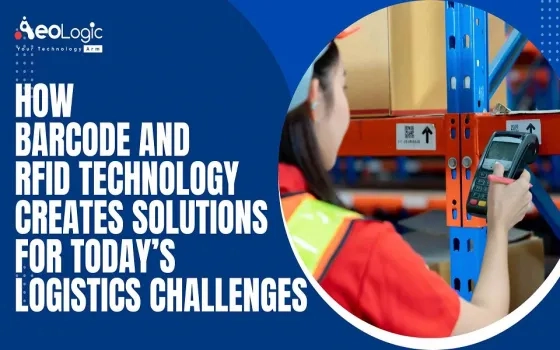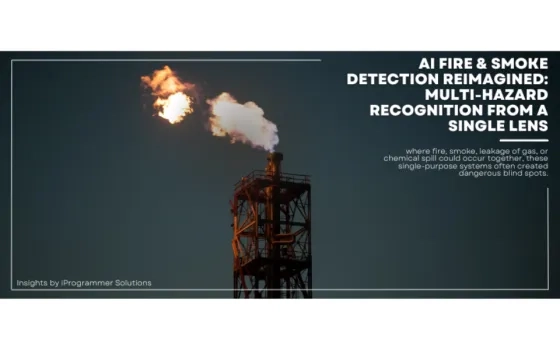The retail, manufacturing, and logistics industries are always looking for the next technical innovation to help them address problems. We have seen this with computerization, the advent of barcoding, and the widespread use of RFID technology. These innovations have allowed retailers to track products in their inventory and avoid out-of-stock. They’ve given manufacturers visibility into every stage of production from raw materials to finished goods. And they’ve transformed how everyone who handles freight does his or her job. In this article, we’ll take a look at “How Barcode and RFID Technology Create Solutions for Today’s Logistics Challenges.”
Let's begin!
Table of contents
- Overview
- What is Barcode Technology?
- What are RFID Systems?
- The Challenges Barcodes and RFID systems
- How Barcodes and RFID Systems Provide Solutions for Logistics Challenges
- What’s the Difference Between Barcoding and RFID?
- Pros and Cons of a Barcode or RFID Technology
- Barcode Technology in Action
- RFID Technology in Action
- Common Uses for Both Technologies
- Both Barcode and RFID Technologies Help Create Solutions for Today's Logistics Challenges
- How Barcodes and RFID Systems Help the Supply Chain
- Final Thought
Overview
Barcode and RFID technology are both used to track and identify objects. However, they work in different ways. One is a machine-readable symbol that’s printed on products and documents, while the other is an electronic device that communicates with other devices via radio waves. These two technologies are often used together to create solutions for today’s logistics challenges.
What is Barcode Technology?
Barcode technology is a system of encoding data in a visual pattern that can be read by electronic devices. Barcodes are commonly used to track inventory, identify products, and streamline checkout processes in retail environments. However, barcodes can also be used to track assets and people in logistics applications.
RFID technology uses radio waves to communicate information between devices. RFID tags are often used in conjunction with barcodes to provide additional data about an asset or individual. These tags can be read at a distance, which makes them well-suited for tracking large numbers of items in warehouses or supply chain applications.
Barcode and RFID technology can be used together to create comprehensive tracking solutions for today’s logistics challenges. By leveraging the strengths of both technologies, businesses can improve asset visibility, optimize inventory management, and reduce operational costs.
What are RFID Systems?
RFID systems are used to track and manage inventory in a variety of industries. RFID tags are attached to products or shipped containers, and the tag's data is read by an RFID reader. This allows businesses to track their inventory in real time, which is essential for effective logistics management.
There are two main types of RFID systems: active and passive. Active RFID systems use battery-powered tags that emit a signal that can be detected by a reader up to 100 feet away. Passive RFID system tags do not have a power source and rely on the energy emitted by the reader to activate the tag. These tags have a shorter range but are much less expensive than active tags.
RFID technology has many benefits over traditional barcode-based tracking systems. RFID tags can store more data than barcodes, and they can be read without a line of sight, making them ideal for tracking inventory in warehouse environments. Additionally, RFID tags are more durable than barcodes and are not easily damaged or destroyed.
The Challenges Barcodes and RFID systems
There are many challenges that need to be addressed when it comes to managing inventory in a warehouse. One of the major ones is keeping track of what's on hand and where it is located, which can be difficult when there are hundreds of items per location. Also, since each item has its own barcode, tracking them individually becomes almost impossible without using RFID technology.
How Barcodes and RFID Systems Provide Solutions for Logistics Challenges
Barcodes and RFID systems are becoming increasingly popular as solutions for logistics challenges. Here's a look at how these technologies can help solve some of the most common issues faced by logistics professionals:
Inventory management: Barcodes and RFID tags can be used to track inventory levels in real-time, making it easy to reorder supplies when needed.
Asset tracking: By attaching barcodes or RFID tags to assets, you can quickly and easily locate them if they're misplaced or stolen.
Shipping and receiving: These technologies can be used to automate shipping and receiving processes, ensuring that products are properly tracked and accounted for.
Security: Barcodes and RFID tags can help deter theft and fraud by providing a visible deterrent and helping to track items if they're stolen.
What’s the Difference Between Barcoding and RFID?
Barcoding and RFID technologies are both ways to automate the process of reading and capturing information about items in inventory. With barcoding, you use a barcode to automate the process of reading and capturing information about items in inventory.
RFID uses radio waves to automatically identify and track items without visual contact. It’s one of the most popular forms of tracking technology today because it offers many benefits over traditional methods such as manual scanning or hand-tagging products with stickers (which can be difficult).
Pros and Cons of a Barcode or RFID Technology
Barcode and RFID technologies offer many potential benefits for logistics operations. However, there are also some potential drawbacks to using these technologies that should be considered before implementation.
PROS:
- Increased Efficiency: Barcode and RFID technologies can help to increase the efficiency of logistics operations by reducing the need for manual data entry and increasing the accuracy of data collection.
- Enhanced Visibility: These technologies can provide real-time visibility into inventory levels and locations, which can help to improve decision-making and optimize stock levels.
- Reduced Costs: The use of barcode and RFID technology can lead to cost savings in a number of ways, including reduced labor costs, improved inventory management, and reduced product losses.
CONS:
- Implementation Costs: There is a cost associated with implementing barcode or RFID technology, which can include hardware, software, and training expenses.
- Potential for Interference: Barcode and RFID signals can be interfered with by other devices or materials, which can impact the accuracy of data collection or cause system downtime.
- Security Risks: The use of barcode and RFID technology can create new security risks if not properly managed, including the potential for data breaches or unauthorized access to information.
Barcode Technology in Action
Barcode technology is used for inventory management, tracking products and their location in a warehouse, shipping and receiving processes, and processing payments.
- Inventory Management: Barcodes are a great way of keeping track of items when they move from one store shelf to another or when they're moved into storage. This helps ensure that stock doesn't get lost or stolen while still allowing you to keep track of what's available at any given time so you can quickly order more if needed.
- Tracking Products: Barcodes make it easy to identify the type of product being shipped from point A (the manufacturer) all the way through point B (your customer). They also allow for complete data capture including weight, dimensions, and serial number so there are no mistakes made during processing time either - which means no more lost orders due solely due to lackadaisical handling!
RFID Technology in Action
RFID technology is a wireless technology that enables computers and devices to communicate with each other using radio waves. The tags contain a chip, which is made up of integrated circuits and antennae that can be read by an RFID reader at any distance.
RFID solutions allow retailers to track inventory, track orders, and keep track of customer data in real time. They also help companies save money by reducing the number of paper transactions required for each transaction, such as when you shop at your favorite store or pay for gas at the pump, and make sure you get what you need quickly without waiting on hold for customer service representatives who may not know your name or understand what’s going on around them
Common Uses for Both Technologies
The more common uses for both technologies include:
Supply chain management. A barcode scanner can be used to identify products and track their journey through the supply chain, from manufacturer to customer. RFID tags allow you to keep track of inventory items, which helps ensure that they are available when needed and that quality standards are met.
Inventory management. Barcodes provide an easy way for inventory systems (such as ERP) to communicate with each other via barcode scanners or RFID readers mounted on shelves or pallets in warehouses along with other types of devices like cell phones that use Bluetooth technology so they can communicate via short-range applications such as mobile phones running apps such as Foursquare which allows users nearby their location where they've checked into venues listed on their account(s).
This allows businesses who want control over their operations while reducing costs associated with manual labor required during busy seasons like Christmas holidays sales periods etcetera."
Both Barcode and RFID Technologies Help Create Solutions for Today's Logistics Challenges
In today's fast-paced, global society where supply chains are stretched to the limit and consumers demand to have their products delivered as quickly as possible, organizations need a methodology that will allow them to keep up with the constantly changing pace of business. Barcode and RFID technology is one such solution that provides solutions for a number of logistical challenges organizations may face.
Both barcode and RFID technologies are key components of a supply chain. They help with inventory management, tracking, and tracing. Barcodes are used to track inventory in the warehouse and RFID is used to track inventory in transit.
Barcodes can be used on all types of products, including textiles and plastics; they’re also becoming increasingly popular for use on food products as well. In addition to helping with traceability, they also provide greater visibility into your product flows so you can see exactly what’s going out of your warehouse or onto trucks when they leave your facility.
How Barcodes and RFID Systems Help the Supply Chain
Barcodes and RFID systems are important tools that help the supply chain function smoothly. Barcodes are used to track inventory and keep track of products as they move through the supply chain. RFID tags can be affixed to products and used to track their movement through the supply chain. Both barcodes and RFID tags provide data that can be used to improve the efficiency of the supply chain.
Barcodes are used to track inventory levels and product locations. This information is essential for managing the flow of products through the supply chain. By knowing where inventory is located, businesses can make sure that products are available when needed. By tracking product movement, businesses can identify issues and bottlenecks in the supply chain.
RFID tags provide more detailed information than barcodes. RFID tags can store information about a product’s origin, destination, and history. This information can be used to track individual products as they move through the supply chain. RFID data can also be used to improve customer service by providing businesses with real-time visibility into their inventory levels.
Barcodes and RFID systems help businesses manage their inventory levels and product locations. These systems provide essential data that can be used to improve the efficiency of the supply chain.
Final Thought
Whether you’re a logistics company, an e-commerce retailer, or an agricultural supply company, we’ve got something for you. Our barcode and RFID technology solutions can help your business grow, by reducing the time it takes to get products from point A to B.



















